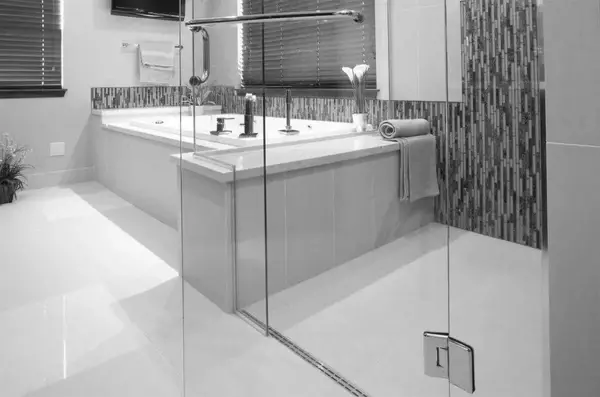The concept of a linear shower drain may be new to many, but its popularity is fast growing, especially among new homeowners. As you settle into your home, you may be considering various upgrades to enhance your space. A bathroom upgrade that is worth considering is the installation of a linear shower drain. This trendy feature offers more than just visual appeal; it provides a range of unexpected benefits that may surprise you.
Table of Contents
What Exactly Are Linear Shower Drains?
Diving right into it, a linear shower drain is a distinctive type of drain that sets itself apart from traditional round drains with its elongated and narrow form. Imagine a sleek line tucked neatly at one end of your shower space, guiding water in a single direction with utmost efficiency. This innovative drain design doesn’t just stop at functionality; it opens up a world of possibilities for personalizing your shower space..
Enhancing Your Bathroom’s Aesthetic Appeal
A linear shower drain isn’t just about function—it’s also a fantastic style statement. This sleek and modern design effortlessly adds an element of sophistication to your bathroom, transforming it into a chic, spa-like retreat right at home. The beauty of a linear drain lies in its simplicity, which exudes a minimalist charm.
Its low profile and clean lines can upgrade your shower area from ordinary to extraordinary in an instant. But the aesthetic appeal doesn’t stop at minimalist elegance. With a plethora of styles, finishes, and lengths to choose from, you get to customize your drain to fit your personal taste.
Whether you want it to blend seamlessly with your bathroom decor or be the standout feature, the choice is yours. In the world of bathroom design, it’s these little details that make a big difference. So why not elevate your shower space with a linear drain that not only works efficiently but also looks stunning?
Easier Installation and Versatility
Think of linear drains as the simpler, more flexible option compared to traditional drains. Their design demands the shower floor to have a single slope, subtracting a layer of complexity from the installation process. This isn’t just an advantage for the installer—it can also mean fewer labor costs for you.
But the benefits don’t stop there! This streamlined design opens up a world of possibilities when it comes to choosing your tiles. Unlike traditional drains that may limit you to smaller tiles, linear drains can accommodate larger format tiles. Imagine the design possibilities!
From eye-catching marble slabs to minimalist porcelain tiles, you get the freedom to choose without having to worry about the practicality of your drain. With a linear shower drain, you get the best of both worlds—a simplified installation process and the versatility to truly make your shower space your own. Now, isn’t that a win-win situation?
Increased Accessibility and Safety
With the smooth, clean design of linear drains, they are an ideal choice for constructing unobstructed, step-free showers. This is a great feature for individuals who are older or may have mobility issues.
Moreover, the efficiency of the linear drain ensures that water only flows in one direction, significantly reducing the risk of water accumulation. This in turn minimizes the risk of slipping accidents, enhancing safety in your bathroom sanctuary.
The ability to maintain a dry, slip-free surface makes your shower area safer and more accessible, offering peace of mind along with modern aesthetics. By incorporating a linear drain, you’re not only upgrading your bathroom’s look but also enhancing its safety and functionality.
This is especially important in homes where residents or frequent visitors may require barrier-free environments for comfortable and secure mobility. A linear shower drain thus does more than elevate the visual appeal of your bathroom—it makes it more inclusive and secure.
Enhanced Cleaning and Maintenance
A common struggle with traditional round drains is the tiresome task of keeping them clean. This is where linear shower drains sweep in with their design that promotes easy upkeep. The first game-changer is the removable grate, which you can simply lift and clean, leaving no room for grime to hide. This quick and simple clean-up process makes maintaining the hygiene of your shower a breeze.
Another advantage is the linear design itself. Traditional drains, due to their design, are more susceptible to clogs that can become a nuisance to deal with over time. Linear drains, with their streamlined design, significantly reduce this problem. The enhanced flow of water helps to keep clogs at bay, thus reducing the frequency of drain clean-ups.
So, not only does a linear drain simplify the cleaning process, but it also helps keep your shower performing efficiently. And who wouldn’t appreciate a solution that makes life easier and reduces the maintenance chores on the to-do list? With a linear shower drain, your shower stays cleaner for longer, freeing up your time for the more enjoyable parts of homeownership. Now, that’s what we call a refreshing shower experience!
Increased Property Value
Not only will a linear shower drain elevate your shower experience, but it can also contribute to a higher property valuation. This fashionable and practical bathroom feature is a plus point in the eyes of potential buyers, adding a level of sophistication and modernity to your home.
Should you ever decide to list your home on the market, a linear shower drain could certainly be a spotlight feature that gives your property an edge over others. From its stunning aesthetics to the various functional benefits it offers, a linear shower drain is a long-term investment that not only pays off in your daily life but can also offer significant returns in the future.
In essence, a linear shower drain is more than just a bathroom upgrade—it’s a smart financial move that boosts the value of your home. So, as you contemplate the various improvements to your home, don’t overlook this one—embrace the unexpected benefits of a linear shower drain, and relish in the knowledge that you’ve made a wise investment in your property.
FAQs About Linear Shower Drains
Is it worthwhile to invest in linear shower drains?
Linear drains are an excellent choice for small showers because they drain water more efficiently. They also have a more modern appearance and may be easier to clean than traditional drains
Do linear drains clog more easily?
Linear drains have a sloped surface that allows water to flow smoothly and eliminates the possibility of clogs. They’re also less difficult to install than traditional drains, with most requiring only a few screws or bolts to secure them in place.
Should a linear drain be installed from wall to wall?
The best linear drain installation is against the wall and wall-to-wall. This type of installation is strongly recommended not only to improve the function of the shower but also to protect the integrity of the rest of the bathroom.
Is it true that linear shower drains are more expensive?
The cost of a linear shower drain unit is generally higher compared to a circular or square shower drain. It is advisable to allocate funds for supplementary labor and installation costs. The installation will require increased coordination between your licensed plumber and tile contractor.
Conclusion
Proper installation of a linear drain necessitates more than the drain unit alone. Additionally, it is necessary to possess the skill to apply mortar at a specific inclination, establish and join drainage pipes, cut and mount tiles, and effectively seal the entire shower to mitigate water damage, decay, and the proliferation of mold. Although a proficient and seasoned do-it-yourselfer can accomplish this task, you may be deficient in the requisite abilities or time to do so. It is advisable to engage the services of a professional to ensure the initial completion of this task is done accurately, so preventing any future complications and ensuring your satisfaction with the final result.

